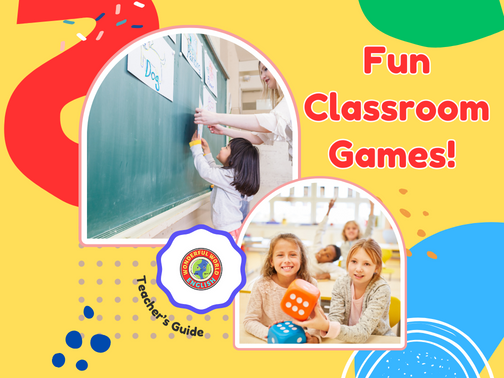
Meet David De’ Ath, founder, editor, and writer at Wonderful World English. With his extensive background as an English teacher, David provides valuable insights and practical tips on ESL for students and teachers alike.
In the dynamic atmosphere of an educational setting, teachers are continuously seeking fresh strategies to maintain student engagement and bolster learning outcomes.
Games have long been celebrated for their ability to combine enjoyment with educational value, providing an interactive platform that supports cognitive development and social skills.
Traditional games such as Hot Potato, Charades, Bingo, and Pictionary captivate students’ attention and foster a sense of community in the classroom. These activities often serve as a delightful segue into lesson topics or as a high-energy conclusion to the school day. Educators are also turning to digital tools to enrich the learning environment.
Platforms like Kahoot! and Virtual Scavenger Hunts offer a unique way for students to immerse themselves in educational content through the use of gadgets and the internet.
By integrating coding challenges, teachers can further expand their curricular reach, allowing students to delve into the foundational aspects of computer science.
These digital options stand as a testament to the evolution of learning tools and pave the way for a modernized method of teaching.
Key Takeaways
- Classroom games, both traditional and digital, are effective in keeping students engaged.
- These activities bolster critical thinking, teamwork, and educational enjoyment.
- Strategic game inclusion serves as a bridge between interactive play and lesson material absorption.

Traditional Classroom Games
Delve into the world of classic games that have stood the test of time, offering simple yet engaging activities for your students.
These traditional games require minimal equipment and preparation, making them a convenient choice for any classroom setting.
In this section, we’ll provide you with everything you need to know to bring these games to life in your classroom.
These games are not just about fun; they’re a creative way to enhance learning and engagement.
Adapt these games to fit your teaching style and lesson plans.
They are versatile and can be tailored to suit various educational needs.
For those interested in using games specifically for English language learning, we’ve got you covered, too.
Check out our comprehensive guide for the best games to learn English, linked below.
Related Article: Best Games to Learn English: Complete Guide
Without further ado, let’s explore the top picks for traditional classroom games:
Now, the best traditional classroom games are as follows:
1. Hot Potato
An energizing activity perfectly suited for groups, Hot Potato is a dynamic game encouraging quick reflexes.
Learners sit or stand in a circle and pass around a small object, akin to a game of keep-away, to the beat of energetic tunes.
When the music ceases, the one with the object in hand faces a minor challenge, often a question related to the lesson to continue participating.
This game perfectly combines physical activity with mental acuity, keeping student engagement high.
Materials and Duration:
- Small item (e.g., a beanbag)
- Music player
- 8 to 10 minutes
Rules:
- Pass the item to music.
- Stop passing when music stops.
- Answer a question to stay in.
Click here to see how this game is played.
2. Bingo!
Bingo! is a classroom staple and is customizable and simple to execute, enhancing vocabulary and concentration.
Learners create their card grids and fill them with words displayed by the educator.
As the game proceeds with words called out at random, students mark their words until they achieve a row or full grid, announcing their win with an exuberant shout.
It supports language acquisition and listening skills development in an entertaining format that only needs paper, pens, and a list of words.
Materials and Duration:
- List of words
- Paper/cards for Bingo grids
- Pens or markers
- Prizes (optional)
- 10 to 20 minutes
Steps:
- Create a grid and fill with words.
- Mark words as they are called.
- Shout “Bingo!” when a row is completed.
Click here to see a tutorial on how to play sticky ball bingo.

3. Charades
Charades is an evergreen game invoking creativity and non-verbal communication prowess.
Participants mime the prompt for the rest of the group to guess, harnessing their body language and pantomime skills, which boosts their imaginative thinking and interpretative ability.
It’s adaptable for diverse group sizes and offers a dynamic break from traditional learning.
Materials and Duration:
- A list of words or phrases
- Timer
- 10 to 15 minutes
Execution:
- Act out the given prompt silently.
- Others guess the mime.
- Rotate the mime player.
Click here to see how this game is played.
Check out the guide below for some more excellent ice-breaker games and activities!
Related Article: ESL Icebreakers: 16 Simple and Effective Ideas for Teachers
4. Simon Says
Simon Says is an active listening and command-oriented activity that delights particularly young learners.
Through following directions prefixed by the phrase “Simon says,” students sharpen their attention to detail and reaction time.
Mistakenly following an instruction without the magic words results in a jovial elimination for that round, always topping up the classroom energy levels.
Materials and Duration:
- Clear space for movement
- 10 to 15 minutes
Gameplay:
- Follow commands starting with “Simon says.”
- Ignore commands without the prefix.
- Avoid wrongful actions to stay in play.
Click here to see how this game is played.

5. Pictionary
Pictionary prompts creative sketching and lively teamwork as participants rush to convey words through illustrations.
The game is excellent for inclusively reinforcing study topics, as the drawn cues can be associated with recent lessons.
With participants rotating as sketch artists, it encourages expressive communication and healthy competition.
Materials and Duration:
- Whiteboard or chalkboard
- Markers or chalk
- List of words
- 15 to 20 minutes
How to Play:
- Divide into teams and draw out words.
- Guess drawings for points.
- Rotate the illustrator role.
Click here to see how this game is played.
6. Word Chain
Word Chain encourages learners to construct a chain of words by connecting the last letter of one word to start another.
The activity is brilliant for enhancing vocabulary and cognitive speed, keeping the class mentally agile and entertained.
By focusing on a specific theme or category for the words, it can effectively be utilized to review academic material.
Materials and Duration:
- No materials needed
- 10 to 15 minutes
Guidelines:
- Start with aword.
- Create chain based on last letters.
- Keep within a theme or category.
Click here for an example of a word chain.

7. Musical Chairs
Musical Chairs is a timeless movement game where rhythm and alertness play pivotal roles.
Players circle chairs as music plays and scramble to sit when it stops, with one less chair than the number of participants ensuring an eliminative aspect.
This active game radiates enthusiasm throughout the class and provides a physical break from traditional seated activities.
Materials and Duration:
- Chairs (one fewer than players)
- Music player
- 10 to 15 minutes
Structure:
- Circle the chairs with music.
- Find a seat when the music stops.
- One less chair after each round.
Click here for a free musical chairs song with stops.
8. Memory Game
Memory Game is a cognitive enhancement activity designed to strengthen memory and concentration.
Players take turns exposing card pairs, trying to find matches from memory after initially memorizing positions.
It is an admirable way to practice recall and focus, valuable skills in any educational discipline.
Materials and Duration:
- Cards with matching pairs
- Playing surface
- 10 to 15 minutes
Play Mode:
- Lay out cards face down.
- Flip two cards per turn to find pairs.
- Remember positions for matching.

Interactive Digital Games for Education
Having explored the realm of traditional classroom games, it’s time to dive into the exciting world of digital classroom games.
The digital landscape offers vast resources that can bring a new level of fun and engagement to your lessons.
The internet is a treasure trove of educational games, each designed to blend learning with interactive play.
These games harness the power of technology to create immersive and captivating learning experiences that can appeal to students of various ages and learning styles.
Below, we will introduce three of the best digital games available.
These games have been carefully selected for their educational value, ease of use, and the sheer enjoyment they offer to students.
Whether you’re looking to reinforce lesson content, enhance critical thinking skills, or provide a fun learning activity, these digital games are sure to enrich your teaching toolkit.
Let’s explore these innovative options for bringing technology into your classroom in a meaningful and enjoyable way:
Interactive Quiz Platforms
These interactive platforms have transformed the way educational games are perceived and played.
By allowing educators to create personalized quizzes, such platforms make the learning process both fun and engaging.
Students can participate using their own devices, tapping into the competitive spirit by earning points for correct answers.
Real-time feedback is an added advantage for educators to gauge comprehension levels.
With drawing and guessing elements incorporated, these platforms adapt to various subjects, amplifying the creative and learning potential in classrooms.
Generally, these services are free for basic usage, with advanced features available through subscription models.
Kahoot! is one such example and has transformed educational gaming, attracting over a billion players yearly with its blend of fun and learning.
This platform enables teachers to craft quizzes and games suited to their students’ abilities, fostering engagement through interactive, device-based participation.
Its competitive nature, with points for correct answers, adds excitement and real-time performance assessment.
Kahoot! also includes creative drawing games, enhancing its applicability across various subjects.
Available for free or with advanced features at $9.99/month through Kahoot!+ Max, it stands as a dynamic, comprehensive tool for interactive and motivated learning.
Digitalized Hunt for Knowledge
Turning the traditional hunt into a digital endeavor, this activity marries the love of mystery with educational goals in an online format.
Teachers can set up virtual treasure hunts that tie into lesson plans, allowing students to hunt for clues and items aligned with the educational material.
The digital scavenger hunt encourages students to utilize their research skills and device proficiency as they race against time.
This game can be as tech-involved or low-tech as desired, permitting a shift from screens to physical environments – an excellent method for spicing up lesson plans with an interactive and competitive flair.
Programming Puzzles
These challenges take education into the realm of problem-solving and real-world application, serving as an advanced method to cultivate logical and technical skills.
Tasks are set on coding platforms, requiring students to resolve problems through structured thinking and ingenuity.
Flexible in duration and complexity, these challenges are adaptable for various learning stages and class timings.
Coding can also be introduced to younger audiences through hands-on, unplugged activities that teach the essence of computational thought without relying on technology.
These educational experiences pave the way for building critical thinking and problem-solving abilities in an enjoyable and contemporary format.
AI is also transforming the way that English language learning is done in the 21st century.
For some insights into this rapidly changing landscape, the guide below is for you!
Related: AI and the Future of English Language Learning: Insights

Guidance for Teachers
When incorporating games into your classroom, it’s crucial to remember that the durations suggested for each game are merely guidelines.
Feel free to adjust these times to better fit your lesson plans and the unique dynamics of your classroom.
For digital games, ensure all students can access the necessary devices.
This inclusivity is vital for creating a fair and engaging learning environment.
Also, it’s important to adhere to safety measures and guidelines when using technology in the classroom. Proper use of tech ensures safety and enhances the learning experience.
These games, both traditional and digital, are more than just fun activities; they are powerful tools that can significantly enhance your lesson plans.
They have been proven effective in fostering engagement, reinforcing learning, and making lessons more enjoyable.
Integrating Gaming Strategies Across Various Disciplines
Customizing games to align with different academic themes can infuse excitement and reinforce subject matter.
Here are a few ways to tailor these interactive tools to your curriculum:
- Language Arts: Alter “Pictionary” to focus on expanding vocabulary knowledge.
- Science: Morph “Memory Game” into a term-definition matching challenge with science concepts.
- Mathematics: Adapt the “Sentence Relay” game to incorporate math problem-solving rather than sentence construction.
The flexibility of these activities allows educators to cater to the educational needs of their students, promoting a stimulating and productive classroom atmosphere.
Sustaining Engagement and Relevance in Teaching
Keeping scholars motivated and absorbed is a cornerstone of effective educational experiences.
Some students may struggle with attention, even during lively game-centric lessons.
Promoting a captivating classroom environment and remaining a teacher who resonates with students involves customizing games to their academic and personal growth needs.
This commitment not only enhances learning pleasure but also cements your reputation as an adaptive and favored educator within your community.
Actively involved students tend to have a more positive and profound learning experience.
Inclusive game sessions are regularly endorsed by learners for making education enjoyable and involving!

Educational Enhancement Through Play
Educational games have proven exceptionally effective in enriching the learning journey for students.
They act as engaging mechanisms that not only captivate students’ interests but also make the assimilation of information more impactful.
Applications of games in a classroom setting tend to foster a spirited and participatory atmosphere, ensuring students take an active role in their own learning process.
- Increased Participation: Students tend to engage more eagerly when games are incorporated, bolstering teamwork and communication.
- Enjoyable Learning: Complex subjects become easier to digest when transformed into an enjoyable format.
- Inclusivity: Games adapt to different learning styles, attending to the varied strengths and preferences of learners.
Interactive and spirited in nature, educational games not only support the absorption of difficult concepts but also promote a nurturing and collective class dynamic.
The application of both classical games and modern interactive digital tools offers distinct benefits to classroom learning.
Teachers are encouraged to tailor these learning tools to their curriculum, aligning them with specific learning objectives and the interests of their students.
| Aspect of Learning Enhancement | Description |
|---|---|
| Motivation | Games invoke excitement, increasing student engagement. |
| Memorability | Fun experiences are more likely to stick in memory. |
| Collaboration | Games encourage teamwork, enhancing social skills. |
| Versatility | Adaptable to different learners and educational targets. |
Strategically integrating games into educational practices can lead to an alluring classroom environment that is not only academically stimulating but also entertaining.
This harmonious blend transforms traditional education, paving the way for a groundbreaking and delightful learning experience that can significantly impact both educators and learners.

Conclusion
Incorporating games into your lesson plans can yield tremendous benefits, significantly enhancing the educational experience.
Games serve as powerful motivational tools, capturing students’ attention and making the learning process more enjoyable and memorable.
These interactive activities foster an engaged and dynamic classroom environment.
Students are encouraged to participate actively and work collaboratively, creating a sense of excitement and enthusiasm for the subject matter.
This approach not only aids in understanding complex concepts but also builds a supportive and inclusive classroom culture.
Moreover, the versatility of games allows them to accommodate various learning styles and needs, catering to students’ diverse abilities and preferences.
Whether it’s a traditional classroom game or a digital interactive activity, each game has the potential to enrich the learning experience in unique ways.
The key is experimenting with these games and finding what resonates best with you and your students.
Feel empowered to adapt and tweak these games to align with your educational goals and your students’ interests.
By doing so, you can create a learning environment that is not only educational but also fun and engaging.
We hope this guide has inspired you and provided you with valuable insights into the world of educational games.
Remember, the goal is to make learning enjoyable for your students.
So go ahead, bring these games into your classroom, and watch as they transform the way your students engage with education.
If you require any support or assistance, feel free to contact us.
Have a fantastic day, and enjoy the journey of making learning fun!
Image Attribution: All images licensed via canva.com



1 thought on “Fun Classroom Games: Engage and Educate with These Ideas”